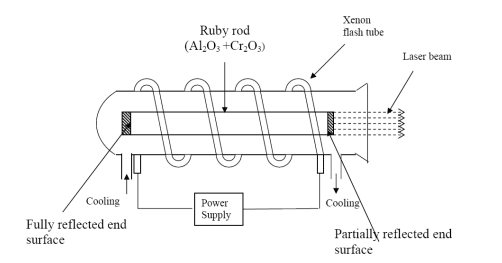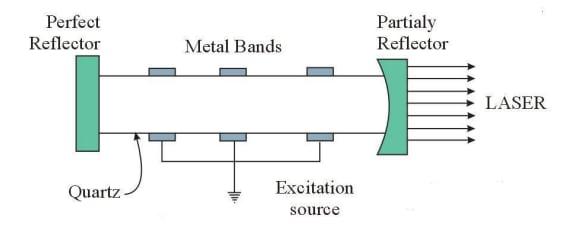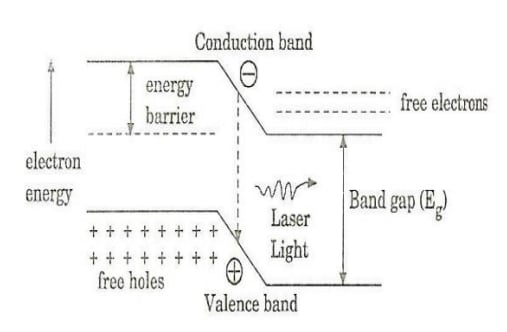Ruby Laser
Ruby laser is a three level solid state laser and was constructed by Mainmann in 1960. Ruby is a crystal of Aluminium oxide, in which 0.05% of ions are replaced by the ions. The colour of the rod is pink. The active medium in the ruby rod is ions.
Construction of Ruby Laser
Chromium atoms doped into the aluminum atoms. The active medium in ruby with which main laser action takes place is ions.
Length of the cylindrical rod lies in between 2 to 20 cm and the diameter of the rod is about 0.1 to 2 cm. The end faces of the rod are polished flat and parallel. In this one face is partially silvered and other face is fully silvered.
Ruby rod is surrounded by the helical Xenon photo flash lamp which provides the pump energy to rise the chromium atom to higher energy level. The parallel ends rod forms an optical cavity so that the photon traveling along the axis of the optical cavity gets reflects back and fro the end surfaces.
Xenon flash tube emits thousands joules of energy in few milli seconds, but only a part of that energy is utilized by the chromium ions while the rest energy heats up the apparatus. A cooling arrangement is provided to keep the experimental set up at normal temperatures.

Working of Ruby Laser
The energy level of ions on the crystal lattice. Consists of three level systems. Upper energy level is short lived state.
When a flash light falls upon the ruby rod, the 5500Å radiation photon are absorbed by ions which are pumped to the exited state . The transition from to is the optical pumping transition.
Now the ions in the exited state give a part of their energy to the crystal lattice and decay to the meta stable state . Hence the transition from to is radiation less transition. Metastable state is long lived state; hence the number of ions goes on increasing, while due to pumping the number in the ground state goes on decreasing.
Population inversion is established between the and . The spontaneous photon emitted by ion at level is of the wave length of about 6943Å.

Drawbacks of Ruby Laser
- Efficiency of ruby Laser is very low.
- The Laser Output is not continuous occurs in the form of pulse of microseconds duration.
- The Laser requires the high pumping power.
- The defects due to crystalline impurities are also presents in the laser.
Helium-Neon Laser
Topic asked in Applied Physics 2023 (CBCS/NEP) question paper Section A - 1(b).
Helium-Neon Laser was first gas Laser to be invented by Ali-Jawan in 1961. The pumping method employed in He-Ne Laser is electrical pumping method and is based on four level pumping scheme. Since He-Ne laser is a gas laser so He-Ne laser have sharp energy levels.
Construction of Helium-Neon Laser
It consists of a long discharge tube made up of fused quartz which is 10 - 100 cm in the length and 2 to 8 mm in the diameter. The tube is filled with and gases under the pressure of 1 mm Hg and 0.1 mm of Hg respectively and are filled in the ratio 10 : 1. Neon is the active center and have energy levels suitable for laser transition. While He atoms help in exiting Neon atom. The electrodes are provided in the discharge tube to provided discharge in the gas which are connected to a high power supply. The optical cavity of laser consists plane and highly reflecting mirror at one end of the laser tube and a Plano-concave output mirror of an approximately 1 % transmission at the other end. To minimize reflection Laser the discharge tube edges are cut at the angle. This arrangement causes the laser output to be linearly polarized.

Working of Helium-Neon Laser
A high voltage is applied across the gas mixture produces electrical breakdown of the gas into ions and electrons. Fast moving electrons are collide with Helium and Neon atoms and exit them to high energy level. atom are more easily excitable than atoms as they are lighter.
The life time of the energy levels and of is more therefore these levels of becomes densely populated. As the energy levels and are close to the exited levels and of . The probability of the atoms transferring their energy to atom by inelastic collision is greater than the probability of coming ground state by spontaneous emission. Since the pressure of the is 10 times greater than the pressure of Neon, the levels and of Neon are densely populated than any other energy levels.
Photons with the energy stimulate the transition from to , to and to . During these transition radiation are emitted with the wavelength of 3.39 , 6328Å and 1.15 respectively.

From the energy levels spontaneous emission occurs in the energy level . Since the energy level is the lower Metastable state then the possibility of atom in the level getting de-exited to the level may occur, if it happened then number of atoms in ground state will go on diminishing and the laser ceases to function. This can be protected by reducing the diameter of the tube so that atoms in follows direct transition to the level through collision with the walls of tube.
The He-Ne Laser operate in continuous wave mode.
Drawbacks of Helium-Neon Laser
- It is relatively low power device means its output power is low.
- He-Ne laser is low gain system/ device.
- To obtain single wavelength laser light, the other two wavelengths of laser need suppression, which is done by many techniques and devices. So it requires extra technical skill and increases the cast also.
- High voltage requirement can be considered its disadvantage.
- Escaping of gas from laser plasma tube is also its disadvantage.
Semiconductor Laser
A semiconductor laser, also known as a diode laser, is a laser device that emits coherent light through the process of stimulated emission, utilizing a semiconductor material as the gain medium. A semiconductor laser typically consists of a p-n junction diode. This diode is formed by doping semiconductor material with impurities to create regions of excess positive charge (p-type) and excess negative charge (n-type). Semiconductor materials are compact, efficient, and relatively low-cost.
Semiconductor Diode Laser Principle
A semiconductor laser, also known as a diode laser, operates on the principle of stimulated emission within a semiconductor material. It utilizes a p-n junction diode, where one side is doped with an excess of positive charge carriers (p-type) and the other side with an excess of negative charge carriers (n-type). When a forward bias voltage is applied across the p-n junction, electrons from the n-type region and holes from the p-type region are injected into the depletion region. Within this region, electrons and holes recombine, releasing energy in the form of photons. Some of these recombination events result in the emission of photons with a specific energy corresponding to the bandgap energy of the semiconductor material. These emitted photons stimulate further emission as they pass through the gain medium, leading to the generation of a coherent laser beam. This process occurs within the laser cavity, formed by highly reflective end facets of the semiconductor material, and is facilitated by optical feedback. Finally, a partially reflective end facet allows a small portion of the emitted light to escape as the desired laser output.
Classification of Semiconductor Laser
- Homojunction Semiconductor laser
- Heterojunction Semiconductor Laser
Homojunction Semiconductor Laser
A simple diode laser which makes use of the same semiconductor material on both sides of the junction is known as a homojunction semiconductor laser. Example: Gallium Arsenide laser (GaAs).
Principle When a P-N junction diode is forward biased the electrons from n - region and the holes from p - region cross the junction and recombine with each other. During the recombination process the photons (light radiation) is released from direct band gap semiconductor (Eg: GaAs) which stimulates other electrons and holes to recombine and hence the stimulated emission takes place which produces the laser

Construction of Homojunction Semiconductor Laser
The basic construction of a semiconductor homojunction diode is shown in the figure. The active medium is a P-N junction diode made from a single crystal of GaAs. This crystal is cut in the form a platelet of thickness 0.5mm.this platelet has a electrical (n-type) and hole conductivities (p-type).

The photon emission is stimulated by a thin layer of PN junction. The potential difference is applied to the homojunction diode through the metal contact .the end faces of the junction are polished and made parallel to each other. They act as optical resonator where the laser comes out.
Working of Homojunction Semiconductor Laser
Figure shows the energy level diagram.

When the diode is forward biased using the applied potential difference, the electron and holes are injected in to the junction where the concentration of holes in p - region and electrons in N - region strengthens. After the population inversion condition is achieved, the electrons and holes are recombined to produce a radiation in the form of light
When the forward biased voltage is increases, the emitted photon multiplies and triggers these recombining photons in phase. These photons moving at the plane of junction travels back and forth by reflection between two sides of the junction and grows in strength. After gaining enough strength it emits a laser beam of wavelength 8400Å.
The wavelength of laser is where - band gap energy.
| Type | Solid state homojunction semiconductor laser |
|---|---|
| Active Medium | PN junction GaAs diode |
| Pumping Method | Direct conversion method |
| Power output | 1 mW |
| Nature of Output | Continuous (or) Pulsed |
| Wavelength | 8400 Å |
Advantages of Homojunction Semiconductor Laser
- It is small in dimension and compact
- It exhibits high efficiency
- The laser output can be increased easily by controlling junction current
- It requires little auxiliary equipment
Disadvantages of Homojunction Semiconductor Laser
- It is difficult to control mode pattern and structure of laser
- Output beam has large divergence
- Monochromacity is poorer than other type of laser
- Threshold current density is large
Heterojunction Semiconductor Laser
A p-n junction made up of the different materials in two regions ie., n type and p type is known as Hetero junction.
Principle When a PN junction diode is forward biased, the electrons from n - region and holes from p - region recombines with each other at junction and emits photons in the form of light at certain direct band gap semiconductor.
Construction of Heterojunction Semiconductor Laser
This laser consists of five layers as shown in the figure. A layer of Ga-As p - type (3rd layer) will act as the active region. This layer is sand witched between two layers having wider band gap viz. Ga Al As-p - type (2nd layer) and Ga Al As-n- type (4th layer). The end faces of the junctions of 3rd and 4th layer are well polished and parallel to each other. They act as an optical resonator.

Working of Heterojunction Semiconductor Laser
When the PN junction is forward biased, the electrons and holes are injected into the junction region. The region around the junction contains large amount of electrons in the conduction band and holes in the valence band. Thus the population inversion is achieved. At this stage, some of the injected charge carriers recombines and produce radiation in the form of light.
When the forward biased voltage is increased, more and more light photons are emitted and the light intensity is more. These photons can trigger a chain of stimulated recombination's resulting in the release of photons in phase.
The photons moving at the plane of the junction travels back and forth by reflection between two sides and grow its strength. A coherent beam of laser having wavelength nearly 8000Å emerge out from the junction region.

| Type | Solid state Heterojunction semiconductor laser |
|---|---|
| Active Medium | PN junction made from different layers |
| Pumping Method | Direct conversion method |
| Power output | 1 mW |
| Nature of Output | Continuous |
| Wavelength | 8000 Å |
Advantages of Heterojunction Semiconductor Laser
- It produces continuous wave output
- The power output is high
Disadvantages of Heterojunction Semiconductor Laser
- It is difficult to grow different layers of a PN junction
- The cost is high
Applications of Laser
Industry
- Lasers can be used to blast holes in diamonds and hard steel
- Lasers are also used as a source of intense heat
- Carbon dioxide laser is used for cutting drilling of metals and nonmetals, such as ceramics plastics glass etc.
- High power lasers are used to weld or melt any material.
- Lasers are also used to cut teeth in saws and test the quality of fabric.
Scientific
- Lasers are used in the field of 3D-photography
- Lasers used in Recording and reconstruction of hologram.
- Lasers are employed to create plasma.
- Lasers used to produce certain chemical reactions.
- Lasers are used in Raman spectroscopy to identify the structure of the molecule.
- Lasers are used in the Michelson- Morley experiment.
- A laser beam is used to conform Doppler shifts in frequency for moving objects.
Medical
- Pulsed neodymium laser is employed in the treatment of liver cancer.
- Argon and carbon dioxide lasers are used in the treat men of liver and lungs.
- Lasers used in the treatment of Glaucoma.
- Lasers used in endoscopy to scan the inner parts of the stomach.
- Lasers used in the elimination of moles and tumors which are developing in the skin tissue.